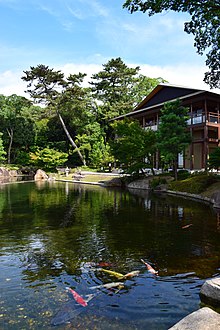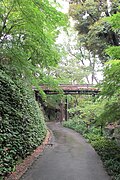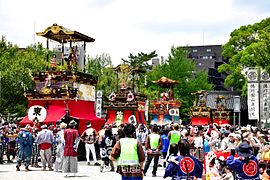Tokugawa-en
The Tokugawa-en ( Japanese 徳 川 園 , Tokugawa-en ) is a Japanese convertible garden from the Edo period in Nagoya , Japan.
history
Tokugawa-en, about 3 km from Nagoya Castle , was built as a retirement home in 1695 by the second head of the Owari branch of the Tokugawa , Tokugawa Mitsutomo ( 徳 川 光 友 ; 1625–1700), and with reference to the name of the area "Ōzone- Residence "( 大 曽 根 屋 敷 , Ōzone-yashiki ) called. The residence was on what was then 44 hectares of land, the waters of which were large enough for 16 boats at the same time. After Mitsutomo's death, the area was used by the vassals Naruse, Ishigawa and Watanabe until the Tokugawa family used the property again in 1889. In 1931 he gave the 19th chief, Tokugawa Yoshichika ( 徳 川 義 親 ; 1886-1976), the residence and the garden to the city of Nagoya, which made some repairs and opened the garden to the public the following year.
During the Second World War, the residence and part of the tree population were lost in air raids. After the war, the park was restored, adapted to the times, then revised again from 2001 and reopened from 2004.
description
The garden has an east-west extension of about 200 m. (The numbering refers to the adjacent plan)
- The Black Gate ( 黒 門 , Kuromon ), outside the plan, was built in 1900 in the form of a Yakui Gate . It survived the bombing in World War II as one of the exceptions.
- Dragon Gate Waterfall ( 龍門 の 瀧 , Ryūmon-no-taki ), also written 龍門 瀑 , is said to have been created with stones from the Owari's secondary residence in Edo on Toyama Hill.
- The Drachenberg Lake ( 龍 仙湖 , Ryūsen-ko ), almost half of the park, is surrounded by large stones.
- The West Lake Dam ( 西湖 提 , Seiko-tei ) quotes the dam over the West Lake near Hangzhou (China).
- The Zuiryū Pavilion ( 瑞龍亭 , Zuiryū-tei ), a pavilion for the tea ceremony, is named after the posthumous name Mitsutomos, Zuiryū-in.
- The tiger tail ( 虎 の 尾 , Tora-no-o ) is a curving watercourse that ends in the Drachenberg lake.
- The Tigerberg Bridge ( 虎 仙橋 , Kosenkyō ) crosses the watercourse at the lower end.
- The Ōzone waterfall ( 大 曽 根 の 瀧 , Ozone-no-taki ) is located at the beginning of the watercourse. Coming from the highest point in the park, the water falls over three steps 6 m.
- The Shisui-Klause ( 四 睡 庵 , Shisui-an ) is surrounded by plum trees. The name, for example "Four Sleepers", refers to a Zen story with the characters Shengan ( 豊 干 ), Hanshan ( 寒山 ) and Shide ( 拾得 ) who sleep while a tiger approaches.
- The Kansen Pavilion ( 観 仙 楼 , Kansen-rō ) is a modern building adapted to the style of the park, which contains a restaurant, a hall and a shop.
Image selection
literature
- Leaflet of the park
- Tokugawa Bijutsukan (Ed.): Tokugawa-en in: Tokugawa bijutsukan gaido bukku. 2015.
Web links
Coordinates: 35 ° 11 ′ 4 " N , 136 ° 55 ′ 57" E








